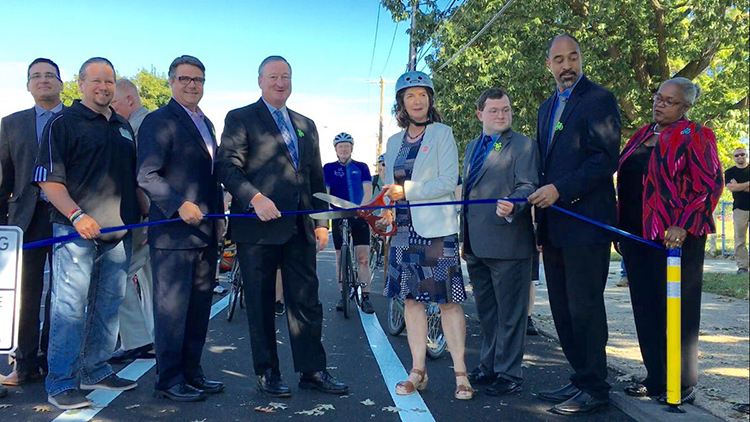Stop and Go for Vision Zero
by Justin Klugh
In the hustle and buzz of an urban commute, we take our lives in our own hands. A driver’s grip on the steering wheel of a two-ton projectile at rush hour is capable of slipping, of getting distracted, of grabbing a phone. Cyclists, too, each day veer around cars, blow past stop signs and ignore traffic laws. Pedestrians give in to their jaywalking urges or are forced into hazardous detours by uprooted sidewalks or construction bleeding into their walkways. At its worst, it’s an orchestra of chaos, held together by painted lines and invisible boundaries.
Needless to say, mistakes are made, and the results can be tragic. In Philadelphia, 100 people a year are killed in traffic accidents. Similarly grim statistics in 1994 inspired a road traffic safety bill in Sweden with a lofty goal: the elimination of traffic deaths. Three years later, it was passed into law and became known as the Vision Zero Project. It was an idea that appealed to governments around the world, and it arrived in Philadelphia in November 2016, when Mayor Jim Kenney signed an executive order that formed our city’s Vision Zero Task Force, aiming for zero deaths from traffic accidents in Philadelphia by 2030.
“Vision Zero was a whirlwind first four months,” says Philadelphia Director of Complete Streets Kelley Yemen, who took over the job last October. The day Mayor Kenney set up the task force was her first day on the job. “We had a four month timeline to release the draft action plan. We made it through that, but now we’ve got it out and we’re looking for comments, we’re doing a lot of community outreach, we’re taking some time right now to build our data inventory and create our high injury network that will all be finalized this fall with the final action plan.”
Yemen and her department’s plan is available at visionzerophl.com, where residents can leave comments or suggestions, and even mark on a map particular areas in which they’ve witnessed any form of street malpractice: speeding, red light running, wayward pedestrian, bad cycling behavior. The Bicycle Coalition’s annual Vision Zero conference held in March of this year provided updates on where the city stood on the project: There is progress, but much work remains.
“I really hope [Mayor Kenney’s] vision can be turned into reality sooner than later. Unfortunately, the political and financial situation in Philadelphia is such that that isn’t enough to make change happen,” says Randy LoBasso, the Bicycle Coalition’s communications manager. “From the ground floor, Philadelphia’s streets are vastly underfunded, and it’s a situation that’s pretty unique to us.”
According to a 2015 report from the Bicycle Coalition, Pittsburgh had set aside 4.2 percent of its city budget on streets, compared to Philadelphia’s 0.7 percent. Baltimore had poured $143 per capita into its roads, whereas Philadelphia was spending $16. LoBasso says the Bicycle Coalition is waiting to see if a plan submitted to City Council by Mayor Kenney will fix this disparity.
An aspect of Vision Zero designed to shield cyclists from accidents is protected bike lanes: roadways for bikers separated from vehicular traffic by barriers, plant beds, parked cars or curbs. Mayor Kenney planned to install 30 miles of PBLs in five years starting in June 2016. The city’s first stretch was opened the following September on Ryan Avenue in Northeast Philadelphia, from Mayfair to Lexington Park alongside nearby Pennypack Park. PBLs were a topic of discussion at the Bicycle Coalition’s conference in March, as well, with the organization citing the (unofficial total of) 76 cyclist deaths in 2016 as motivation to propel the project forward.
“You would think safer streets for bicyclists—and all road users—would be universally appreciated,” says LoBasso. However, there are plenty of ways to stir discontent, LoBasso explains. “Before a meeting about protecting the Spruce and Pine bike lanes in Center City, someone put up posters claiming a protected bike lane would block emergency vehicles and potentially result in the deaths of countless people on their way to Pennsylvania Hospital. Obviously that’s not true, but it gets people riled up.”
For Yemen, the day-to-day job requires education and relationship building. “Even for people who may have seen them in other cities, the question becomes, ‘How is that going to fit into the context of our streets in such an old street network and a historic grid?’”
Yemen says her department is trying to get a PBL installed on Chestnut Street between 34th and 45th by the middle of this summer and that American Street will eventually have a race cycle track. “We’re on our way,” she says. “We have over $600,000 in combined state and federal grant funding for PBLs. That won’t get us all the way to thirty [miles], but it will get us a good way there.”
“Philadelphia is the most-biked big city in the United States, which is great,” LoBasso says. “But a good 60 percent of citizens here fall into the ‘interested but concerned’ category for cyclists, and I want a city where those people feel safe getting on their bikes with their families and going to work, school or wherever they want.”
Progress, like rush hour traffic, is stop and go. LoBasso says despite the pace, Vision Zero and protected bike lanes are moving forward. “I just wish the process would speed up,” he says.





There is only one way to achieve zero traffic deaths in an area, that is to find a way to effectively reduce the travel speeds of all vehicles to zero mph. If all cars, trucks, buses, trams, Segways, power wheel chairs, bicycles, skateboards, etc. have controls so their maximum travel speed cannot exceed zero mph – then there will be no traffic crashes with moving vehicles that cause fatalities.
Commerce will collapse, but the area will be quite safe.
James C. Walker, National Motorists Association
1) Your response, in its oversimplification, serves no cause, not even that of the National Motorist Association–which it appears, consists of you and your email account.
2) Numerous charts are available which show the sharp increase in serious injuries and fatalities when motorists strike pedestrians. Please consult them before your next ignorant post. mcget / trophy bikes PHL
While Mr. Walker charitably identifies himself as a lobbyist for the automobile, and while I know all fatalities are not due to his favorite mechanism of death — my great grandmother was run down and killed by a horse drawn fire engine on South St. in Philadelphia more than a few years ago — he has a point. I am not inspired by goals which are impossible. Zero traffic deaths, zero tolerance for violence in schools, etc. are in my view self defeating sloganeering, not strategic goals for social reform.